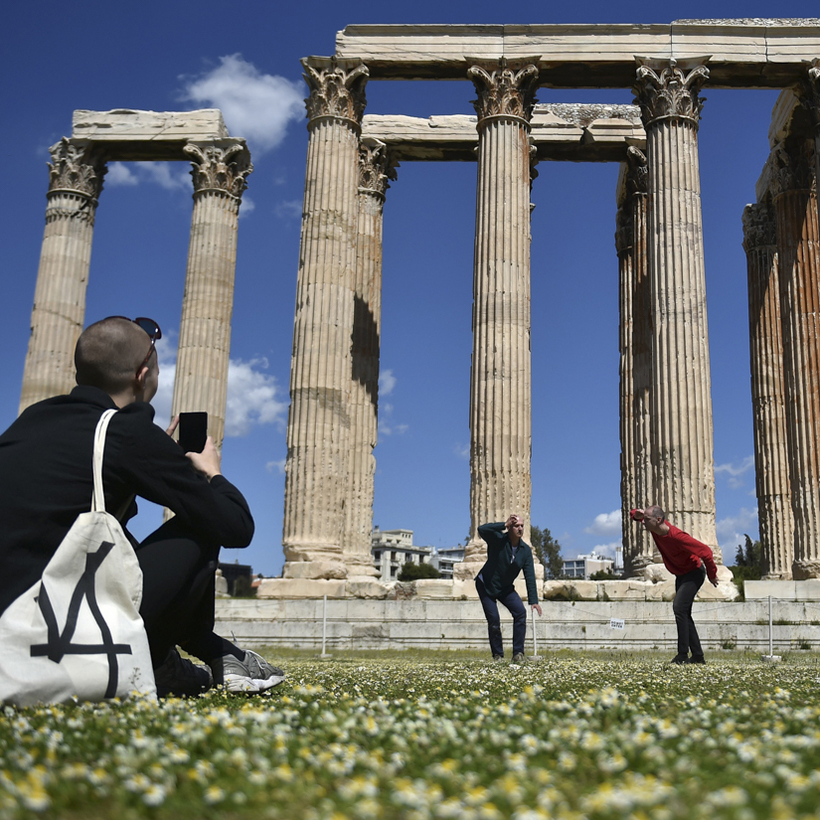Last year, a ticket to a live performance by Patti Smith at the open-air Herodes Atticus amphitheater brought me back to Athens. It ended up being the unexpected memory trigger for re-discovering the city where I had lived as a child.
When Smith railed against political injustice in a rain-soaked rendition of “Gloria,” the Athenian audience members were ecstatic. Here was the legendary singer-poet, saluting the nation for prevailing over a tumultuous decade of bankruptcy and disillusionment.
They took the anthem as their due, savoring its lyrics and melodies tinged with a chorus of harmolypi, a distillation of melancholic joy that is uniquely Greek. I have since returned twice to the city whose explosive energy packs more punch than perhaps any other European capital.

Smith, high priestess of punk, was the fulcrum of my teenage aspirations—everything that involved poetry, photography, the Lower East Side, and unshaved armpits. Yet the Athens of my school days, in the late 70s and 80s, was emerging from a brutal military dictatorship. Then it was backwater, not a hotbed of the counterculture.
Athens is an accidental capital in search of an identity, even nearly 200 years after achieving independence from the Ottoman yoke. The key components of a night on the town were Karelia cigarettes in a flip-lid box; a café frappé at the Art Deco Open Air Cinema Thision (still open today); and gyros at O Kostas, also still going strong.
The financial crisis that caused a humanitarian and social collapse a decade ago ended up galvanizing Greece’s creative and entrepreneurial spirits. The art scene, lubricated by a flow of activism, was the response—the howl of anger—of a society under pressure. In the past decade, Athens has drawn expats from the United States and Europe due to its relatively low cost of living. Now it’s a playpen for artists and hipsters, as Berlin was 20 years ago.

The Stavros Niarchos Foundation Cultural Center, which opened in 2016, was key to igniting this movement. Under its Renzo Piano–designed atrium, watching tango, listening to jazz, and even participating in a workshop can be exhilarating.
Athens is an accidental capital in search of an identity, even nearly 200 years after achieving independence from the Ottoman yoke.
The following year, the German cutting-edge arts festival Documenta 14 relocated to Athens. Then homegrown entrepreneur Dimitris Daskalopoulos established Neon, a nonprofit foundation that stages public art exhibitions around Greece. Daskalopoulos’s private contemporary-art collection has recently been donated to the E.M.S.T., the National Museum of Contemporary Art, which relaunched during the pandemic in the former shell of the Fix brewery.

Away from the glossy, central Syntagma Square and Kolonaki districts, amid the unvarnished squalor of potholed streets and broken pavement in outlying neighborhoods, art spaces and workshops mushroom in abandoned heritage buildings and industrial landmarks.
Collaborative working spaces such as Romantso, a former printing press in Omonia that doubles as a club, have also helped make once provincial Athens feel more like Berlin. In an impressive show of faith, Larry Gagosian opened his second Athens Gagosian gallery in 2020. There, he staged a homecoming exhibition for the artist Marc Newson, who has Hellenic roots. Not bad for what was once the black sheep of the European Union.

Marios Schwab, the Austrian-Greek designer, has also renewed his focus on his hometown. After cementing his status as a major designer working in both Paris and London, he returned to Athens as creative director of the fashion-and-lifestyle label Zeus+Dione. We meet up in the city’s most glamorous restaurant-café, Athénée, the former Zonars, opposite the Z+D flagship store. Today he describes the city as having a sense of “cinematographic dereliction” similar to the one that made Berlin so special in his student days. “Both cities have feet in different centuries,” he says.
As a brand born during the identity crisis of the economic meltdown, Zeus+Dione championed the country’s heritage and regional artisanal skills. The bouzouki instrument and the rebetiko music were once banned, but they are now, if not mainstream, hugely popular in the grungier Athens neighborhoods such as Exarcheia, at Aggelos, and at Petralona’s Hammam.

The re-discovery of Greek heritage also brought designer Andria Mitsakos over from the United States. “Crisis breeds creativity, and I was determined to be part of that,” she says. A decade later, she opened her design-focused shop, Anthologist, in a neoclassical building in Vathi. The area is still down at the heels, yet close to Omonia, where a major real-estate investment is underway. At the shop, 70s-style sofas and stained-glass tables are sold alongside a cornucopia of evil-eye charms and giant komboloi worry beads.

Inevitably, all of this has led to a boom in the formerly lackluster hospitality industry. “Greek-ness” sells, and a new generation of boutique hotels has opened in the historic tangle of streets between Syntagma and Monastiraki Squares. They offer not only sharp, urban design but a contextual sense of place.
Mona, in a former textile factory in Psyrri, flourishes as a kind of clubhouse hotel—the cool kid on a graffitied block. The raw, industrial vibe continues inside, with exposed pipes and terrace tables fashioned from upcycled chicken wire.

I loved the handicrafts for sale, especially the made-in-Athens wool wraps that were originally used as guest-room décor. Simplicity and authenticity have always been hallmarks of the Greeks’ aesthetics and gastronomy, and they are best expressed at Xenodocheio Milos, a hotel and restaurant that launched last year.
Meanwhile, the Gatsby and Ergon House (located above the food emporium of the same name) have helped animate the hotel scene in Athens. Both also serve as a social hive for the community. It bodes well for the swaths of empty and crumbling mansions in the historical center, for which foreign interest and investment has increased by 60 percent since last year, according to the Bank of Greece.

From grand to village-y, industrial to bucolic, the landscapes here are constantly shifting. When walking through the camomile-threaded meadows of Philopappos Hill, I considered the possibility of returning to live in the paradoxical city. I stopped in front of a graffitied message: Don’t Forget to Smile. Defacing an ancient wall of the agora; it’s both amusing and maddeningly anarchic. Just like Athens itself.
Catherine Fairweather is a West Country of England–based writer


